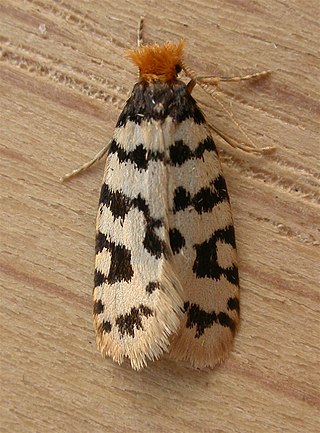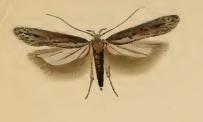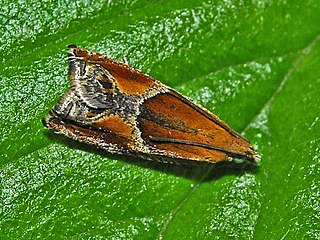
The Psychidae are a family of the Lepidoptera. The bagworm family is fairly small, with about 1,350 species described. Bagworm species are found globally, with some, such as the snailcase bagworm, in modern times settling continents where they are not native.

Pandemis heparana, the dark fruit-tree tortrix or apple brown tortrix, is a moth of the family Tortricidae.

Swammerdamia pyrella is a moth of the family Yponomeutidae. It is found in Europe, North America and Japan.

Notocelia rosaecolana is a moth of the family Tortricidae. It is found in the Palearctic realm, where it has been recorded from China, Mongolia, Korea, Japan, Iran, Central Asia, Russia and Europe.

Crambus pratella is a species of moth of the family Crambidae. It is found in Europe and Asia Minor.

Elophila nymphaeata, the brown china mark, is a species of moth of the family Crambidae. It was described by Carl Linnaeus in his 1758 10th edition of Systema Naturae.

Parapoynx stratiotata, the ringed china-mark, is a moth of the family Crambidae. The species was first described by Carl Linnaeus in his 1758 10th edition of Systema Naturae. It is found in Europe where the distribution area extends in the north to the British Isles including Ireland and in the south to Sardinia, Sicily and Greece. The species is also found across the Palearctic in North Africa, Lebanon, Turkey, Azerbaijan, Kyrgyzstan, Uzbekistan and China..

Platytes alpinella is a species of moth of the family Crambidae described by Jacob Hübner in 1813. It is found in Europe, the area surrounding the Caucasus and the eastern part of Russia.

Falcaria lacertinaria, the scalloped hook-tip, is a moth of the family Drepanidae. The species was first described by Carl Linnaeus in his 1758 10th edition of Systema Naturae It is found in Europe and Anatolia then east to Eastern Siberia.

Epinotia solandriana is a moth of the family Tortricidae. It is found in Europe, China, Korea, Japan, and Russia.

Spilonota ocellana, the bud moth, is a moth of the family Tortricidae. It is found in the Palearctic realm, from North Africa and Europe to Iran, eastern Russia, China, Korea, and Japan. It is also present on Madeira and in North America.

Archips rosana, the rose tortrix, is a moth of the family Tortricidae. It is found in both the Palearctic and Nearctic realms.
There are various disparate groups of wingless insects. Apterygota are a subclass of small, agile insects, distinguished from other insects by their lack of wings in the present and in their evolutionary history. They include Thysanura . Some species lacking wings are members of insect orders that generally do have wings. Some do not grow wings at all, having "lost" the possibility in the remote past. Some have reduced wings that are not useful for flying. Some develop wings but shed them after they are no longer useful. Other groups of insects may have castes with wings and castes without, such as ants. Ants have alate queens and males during the mating season and wingless workers, which allows for smaller workers and more populous colonies than comparable winged wasp species.

Euchoeca is a monotypic moth genus in the family Geometridae erected by Jacob Hübner in 1823. Its only species, Euchoeca nebulata, the dingy shell, was described by Giovanni Antonio Scopoli in 1763. It is found in the Palearctic realm, from Europe across Russia to Japan.

Eulia ministrana is a moth of the family Tortricidae. It is found in the Palearctic and Nearctic realms.

Scrobipalpa artemisiella is a moth of the family Gelechiidae. It is found in most of Europe, Turkey and Syria through the Caucasus and Central Asia to Irkutsk and Mongolia. It has also been recorded from North America, but this records requires confirmation.

Parley Common is a Site of Special Scientific Interest (SSSI) on the edge of Ferndown in Dorset, England. The majority land owner is the Canford Estate, but among the other owners are the Diocese of Salisbury, Dorset County Council, East Dorset District Council and a few private individuals. Most of the site is managed by the Amphibian and Reptile Conservation Trust (ARC); East Dorset Countryside Management Service manage the area owned by East Dorset District Council and Dorset Countryside manage the area owned by Dorset County Council. The site was notified as an SSSI in 1983.

Acanthopsyche atra, the dusky sweep, is a moth of the family Psychidae. The habitat consists of heath and moorland.

Eucosma cana, the hoary bell, is a species of moth of the family Tortricidae.

Ancylis obtusana, the small buckthorn roller, is a moth of the family Tortricidae.



















